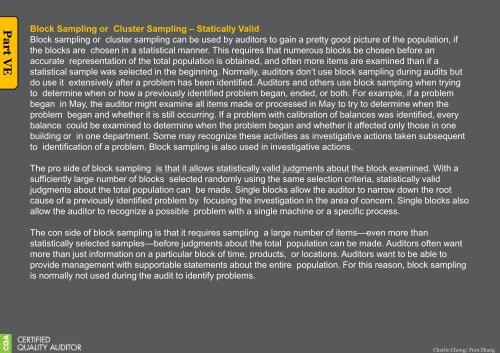My Reading on ASQ CQA HB Part V Part 2
You also want an ePaper? Increase the reach of your titles
YUMPU automatically turns print PDFs into web optimized ePapers that Google loves.
Charlie Ch<strong>on</strong>g/ Fi<strong>on</strong> Zhang<br />
<strong>Part</strong> VD1<br />
Achieving Breakthrough Improvement<br />
Building <strong>on</strong> Shewhart’s noti<strong>on</strong>s to develop a systematic method for improvement, Juran distinguished between<br />
sporadic and chr<strong>on</strong>ic problems for quality improvement projects (QIPs). Starting from a state of chaos, a QIP<br />
should first seek to c<strong>on</strong>trol variati<strong>on</strong> by eliminating sporadic problems. When a state of c<strong>on</strong>trolled variati<strong>on</strong> is<br />
reached, the QIP should then break through to higher levels of quality by eliminating chr<strong>on</strong>ic problems, thereby<br />
reducing the c<strong>on</strong>trolled variati<strong>on</strong>. The noti<strong>on</strong>s of c<strong>on</strong>trol and breakthrough are critical to Juran’s thinking. The<br />
following scenario dem<strong>on</strong>strates this c<strong>on</strong>cept: A dart player throws darts at two different targets. The darts <strong>on</strong><br />
the first target are all fairly close to the bull’s-eye, but the darts are scattered all over the target. It is difficult for<br />
the player to determine whether changing stance (or any other variable) will result in an improved score. The<br />
darts thrown at the sec<strong>on</strong>d target are well off target from the bull’s-eye, but the locati<strong>on</strong> of the darts is clustered<br />
and therefore predictable. When the player determines what variable is causing the darts to miss the bull’seye,<br />
immediate and obvious improvement should result. The impetus behind Juran’s work is to achieve repeatable<br />
and predictable results. Until that happens, it will be almost impossible to determine whether a quality<br />
improvement effort has had any effect. Once a process is in c<strong>on</strong>trol, breakthroughs are possible because they<br />
are detectable. The following points are essential to an understanding of variati<strong>on</strong>:<br />
• Everything is the result or outcome of some process.<br />
• Variati<strong>on</strong> always exists, although it is sometimes too small to notice.<br />
• Variati<strong>on</strong> can be c<strong>on</strong>trolled if its causes are known. The causes should be determined through the practical<br />
experience of workers in the process as well as by the expertise of managers.<br />
• Variati<strong>on</strong> can result from special causes, comm<strong>on</strong> causes, or structural variati<strong>on</strong>. Corrective acti<strong>on</strong> cannot be<br />
taken unless the variati<strong>on</strong> has been assigned to the proper type of cause.<br />
For example, in Deming’s bead experiment (white beads = good product, red beads = bad product) the workers<br />
who deliver the red beads should not be blamed; the problem is the fault of the system that c<strong>on</strong>tains the red<br />
beads. • Tampering by taking acti<strong>on</strong>s to compensate for variati<strong>on</strong> within the c<strong>on</strong>trol limits of a stable process<br />
increases rather than decreases variati<strong>on</strong>. • Practical tools exist to detect variati<strong>on</strong> and to distinguish c<strong>on</strong>trolled<br />
from unc<strong>on</strong>trolled variati<strong>on</strong>.

















